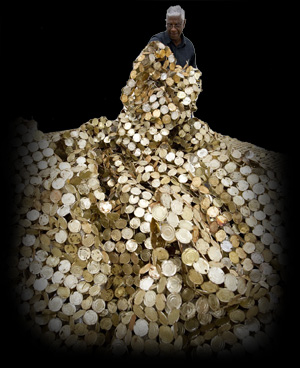Africa in the Works of El AnatsuiA Fateful Journey

INTRODUCTION

For a long time, contemporary African art received little attention outside Africa, but after the “Magiciens de la Terre” exhibition held in Paris in 1989, many in the art world started to take notice. From that point on, exhibitions related to modern African art have been held all over the world, and this has led to a series of symposiums and publications.
In recent years, the sculptor El Anatsui (1944–), who was born in Ghana but now resides in Nigeria, has become known for using the caps of wine and beer bottles, as well as refuse like discarded labels, to weave large textiles on an elegant scale. He is a brilliant artist active, not just in Africa, but globally as well—he has already been invited twice to the Venice Biennale exhibition, and his works are prominently displayed in museums and galleries.
However, the environment surrounding African artists is a complex one. For instance, their “home” is often in a state of limbo between various museums and galleries. As an example, El Anatsui’s works can be seen in the British Museum in London and the Centre Pompidou (National Museum of Modern Art) in Paris.
In this exhibition, we proactively recapture the circumstances in which this type of African art has been placed and tell the story of El Anatsui’s world of art from the dual perspectives of art history and cultural anthropology. Through this, we seek out a new, creative, cooperative alliance between art history and anthropology, as well as art museums and ethnological museums.





